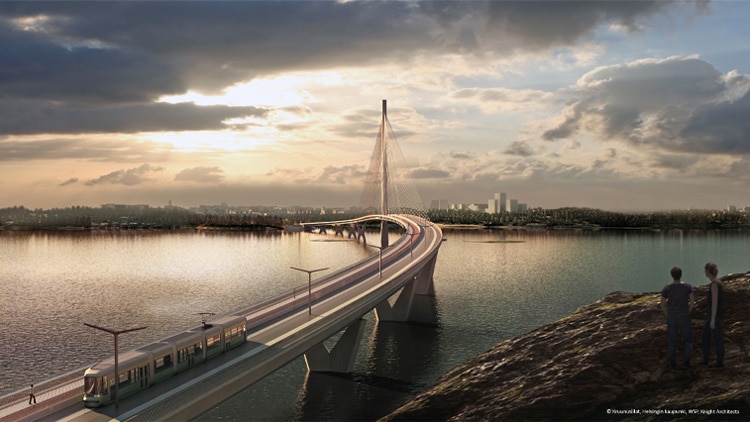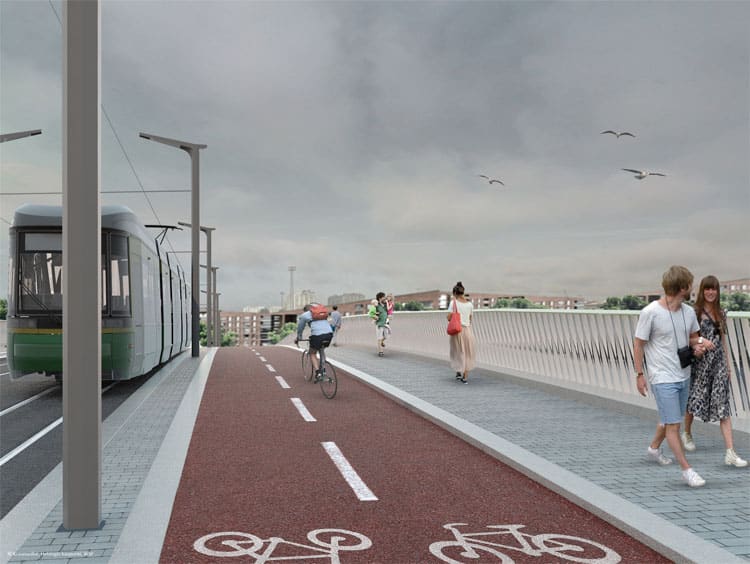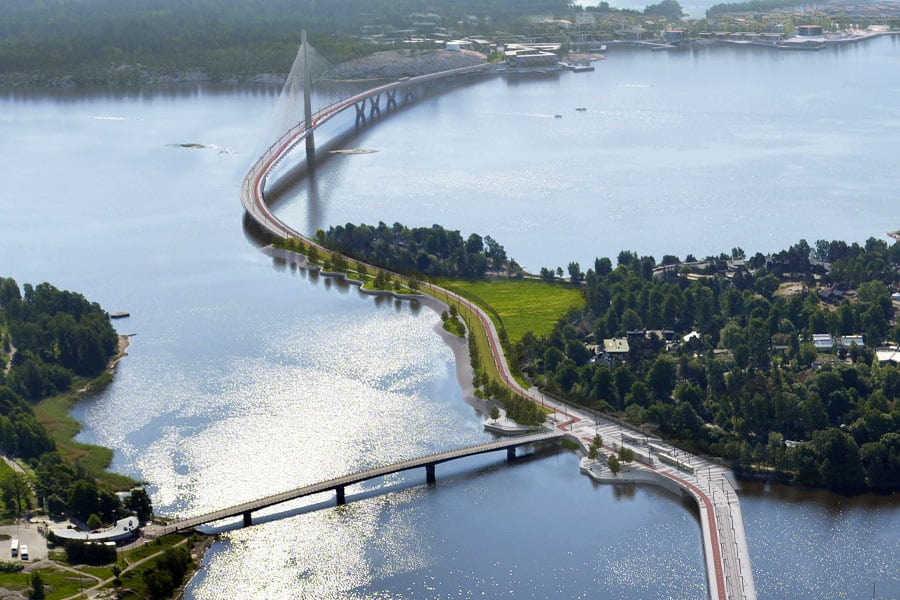In October 2021, Helsinki joined a growing list of European cities investing in tram construction as transportation for the future.
Helsinki, the capital of Finland in Europe’s far north, is a rapidly growing city that prides itself on sustainability and integration with the natural world. With that in mind, its city council recently approved construction to begin on the Crown Bridges (in Finnish: Kruunusillat) light rail project, with a final budget of €326 million.
The project will create a tram and bicycle/pedestrian path connection between the rapidly developing residential island of Laajasalo and the city center. The most significant of the construction is the 1.2km (just under 1 mile) Kruunuvuorensilta bridge, designed by Knight Architects in coordination with engineers WSP Helsinki. The rest of the project will be completed through an alliance model with several different companies using integrated project delivery.
Principles of growth
Helsinki’s population of 650,000 is expected to increase beyond 700,000 by 2027, while the nearby island of Laajasalo is projected to double in population with the development of a new residential district.
Anni Sinnemäki, Helsinki’s deputy mayor for urban environment, explained how that growth influenced the Crown Bridges project: “Helsinki is a growing city that needs new housing,” she said. “At the moment, we are building 7,000 new apartments every year, soon 8,000 per year. Our principle is to connect new public transport investments with new housing so that everyone will have a good public transport connection from their neighborhood.”

The connection to Laajasalo was first envisioned by the city in 2002, and by 2008 the decision had been made to use a light rail connection. Why a tram?
“Many different possibilities were studied beforehand, and a tram turned out to be the most functional one,” Sinnemäki said. “A tram prevents the new inhabitants of Laajasalo from getting stuck in traffic, a risk we would face with a bridge developed for cars. We also need to build a traffic system that is efficient and helps us reach our climate goals. According to our city strategy goals, we need to reduce the amount of emissions our transport system causes.”
Helsinki prides itself on promoting green values and prioritizing environmental protection. The Crown Bridges will join an already robust public transport network that includes tram, metro, train, bus, bike share and ferry.
“I’d like to believe we are a city that looks into the future,” Sinnemäki said. “We want to make sure that the growth of the city is as sustainable as possible and enable a life where our citizens don’t need personal cars in their everyday lives.”
Despite political pushback on the price and lack of lanes for private cars, the tramway and its clear principles won out. “We take pride in reaching our goals of being carbon neutral by 2030,” Sinnemäki said. “The best way to do it is to provide an attractive enough public transport that people will gladly choose it over cars.”
Tram construction resurgence in Europe
As the United States sits on the verge of massive infrastructure spending as a result of the recent passage of new legislation that could spark similar developments stateside, European investments in light rail infrastructure continue to grow. Helsinki’s Crown Bridges fits in with a wider trend throughout Europe.

This past year alone has seen widespread investment in building or renovating tramways on the continent, including Lisbon (Portugal) €43 million; Sarajevo (Bosnia & Herzegovina) €40 million; Sevilla (Spain) €19.6 million; Brandenburg (Germany) €110 million; and Paris (France) €404 million.
Moreover, as concerns over car congestion and emissions grow in Europe, the resurgence of tramways draws comparisons to their introduction centuries ago, when they were first preferred over horses as a cleaner, less waste-producing option for city transit.
The Crown Jewel of Kruunusillat
In 2012, Knight Architects, together with WSP Helsinki, won an international design competition for the bridge. Tom Osborne, director of bridges and infrastructure at Knight Architects, explained how the city’s culture influenced the firm’s design: “There is a strong walking/cycling and active transport culture in Helsinki, and the interaction between the bridge and the urban realm, which it connects, was a constant consideration.”
The design of the Kruunuvuorensilta bridge takes into account a unique combination of challenges. “Climatic conditions were a significant influence on the design,” Osborne said. We worked hard to create a parapet that shields pedestrians from the wind, whilst maintaining views and a sense of openness. It is dark and cold for several months throughout Helsinki’s winter, and so maintaining a good level of comfort and safety throughout the year is a big challenge.”

“Lastly, the brief called for a 200-year design life, which exceeds the typical 120 years of other bridges,” Osborne added. “We worked closely with the engineer WSP Helsinki to design a durable and even adaptable bridge to ensure it becomes a lasting addition to the city.”
The design also considers renowned Finnish aesthetics. “We love the clarity and minimalistic nature of Finnish design, and we hope the bridge becomes a fitting addition to Helsinki, a ‘diamond’ for the city, which was crowned World Design Capital in 2012,” Osborne said.
Collaborative alliance
The project outside of the Crown Bridge will be completed through an alliance model. The alliance will focus on earthworks, street construction and municipal engineering duties as it builds out the rest of the tramway infrastructure.
What is the alliance model?
Jani Saarinen, managing partner of Vision Ltd., the consultant for the alliance model on this project, explained: “Project alliance is a new type of implementation model in which the project partners jointly develop project plans and solutions and draw up a joint implementation plan and target cost,” Saarinen said. “The parties then share the risks and benefits of the project together.”

The alliance model benefits in the sharing of information and expertise across the project. “All the member companies of the alliance are working together,” Saarinen said. “There are three design and consulting companies and two construction companies. The project utilizes the expertise and resources of all these companies on a best for a project basis.”
The alliance is a working partnership that depends on transparency and collaboration. “The idea is to integrate all the companies and their resources as much as possible to work together in the same project office (big room) and to utilize same processes and working methods,” Saarinen said.
Construction on Crown Bridges began in November 2021. The tramway is expected to be completed and in operation by 2027.












